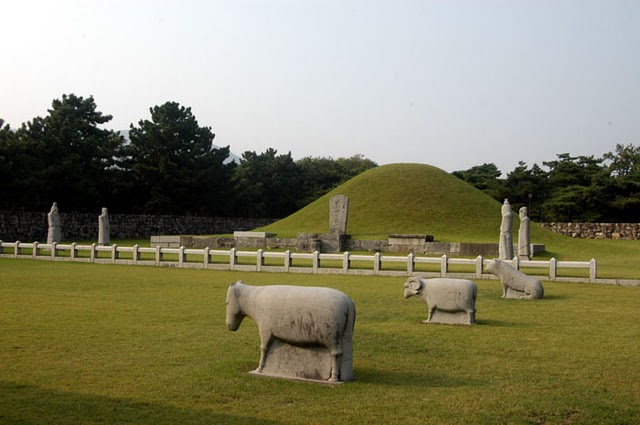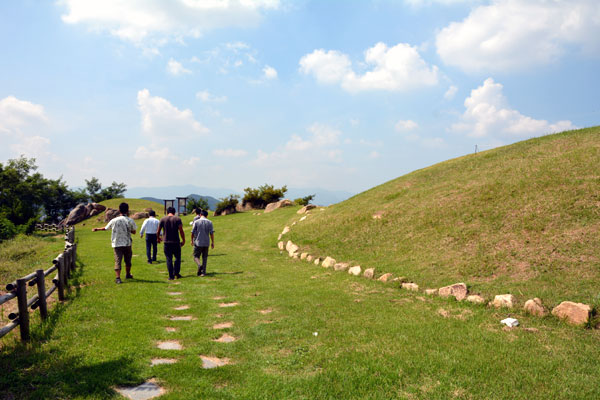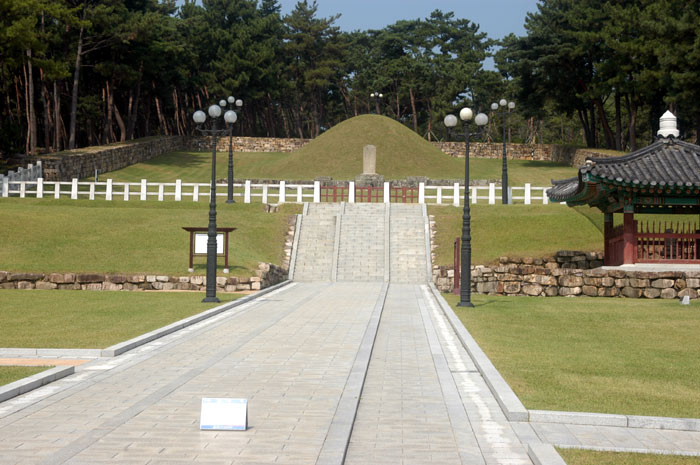Geumgwan Gaya Historic Site No. 73 Suro Royal Tomb in downtown Gimhae
Gimhae, located between Busan City and the Nakdong River, is a city where the culture of an ancient country called Gaya, well-known in Japan as the kingdom of iron, flourished. When King Kim Suro, who became the progenitor of the Gimhae Kim clan, founded Garakguk (Geumgwangaya) in AD 42, the Geumgwangaya Federation, which was located in the southern part of the Korean Peninsula, and six small countries, the Gaya Federation, were formed.

Geumgwan Gaya, where the iron culture flourished centering on Gimhae, was annexed to Silla in 532, and Daegaya, the hometown of Goryeong, Gyeongsangbuk-do, was destroyed by Silla in 562.
King Kim Suro, who founded Geumgwan Gaya, is said to have been born with six golden eggs coming down from the sky to Gujibong, adjacent to the tomb of Queen Suro, and each child born from the egg became the king of 6 Gaya, and named the first child King Suro.
The road to the tomb of King Kim Su-ro
Get a map of Gimhae city from the tourist information center in front of King Suro Tomb, and enter the right entrance of the main gate of King Suro Tomb with the Taegeuk pattern, and there is Hongsalmun right in front of you. Hongsalmun, which means sacred area, is a place where only gods go, and visitors must go through the paths on either side of the gate.
Gimhaesuro Royal Tomb Shineo Statue (神魚像)
The statue of Shineo painted on the main gate, also called the Tomb of King Suro or Napneung, surrounded by a low wall, is a fish pattern commonly found in Ayutah, India, and is said to support the theory that King Suro’s queen came from India.

Tomb of King suro
According to 『Jibong Yuseol』 compiled in 1614, the structure of the tomb is presumed to be a stone chamber tomb, and the tomb was stolen during the Japanese Invasion of Imjin.
Kim suro Royal Tomb Sacrifice Facility
In addition to the royal tombs, in addition to the royal tombs, there are ancestral facilities such as Anhyanggak, Jeonsabyeok, and Jegigo, Sungseonjeon, which enshrines the relics of King Suro and his queen, and Sunganjeon, where the relics of kings and queens from the 2nd to 9th generations of Garakguk are enshrined. It is said that descendants gather and hold ancestral rites every year on March 15 and September 15 of the lunar calendar at Sungseonjeon. In the area to the left of the royal tomb, there are the Garak Relics Hall, the Gimhae Kim family genealogy, and the Sungjae of Gyeongmomun, which also stores the costumes worn by former President Kim Dae-jung.
Monument to King Kim suro during the Joseon Dynasty
In the 13th year of King Seonjo (1580) of the Joseon Dynasty, Heo Yeop, a descendant of King Kim Suro, who was a governor of Yeongnam at the time, significantly rebuilt the tomb of King Suro together with the tomb of Queen Suro. He also erected a tombstone engraved with the words 露王陵). In the 21st year of King Gojong (1884), the government rebuilt the shrine under the name of Sungseonjeon, and it continues to this day.
| Basic information | |
|---|---|
| Name | Royal Tomb of King Suro 김해수로왕릉 金海首露王陵 |
| Address | 312 Seosang-dong, Gimhae-si, Gyeongsangnam-do 경상남도 김해시 서상동 312번지 |
| Telephone | 055-332-1094 |
| business hours | 9:00〜18:00(11月から2月は9:00〜17:00) |
| Admission Fees | Free |


























Add comment